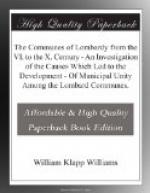The relations of the bishop to the inhabitants of the cities during the period we are considering were pretty nearly such as described in the first part of this paper. He stood forth as protector of the weak and the oppressed; as mediator between an unfortunate prisoner and an unjust judge who was seeking his private interest rather than following the spirit of impartial justice; or between a downtrodden vassal and the almost unlimited power of his feudal superior. He lessened the severity of harsh judgments, he protested the imposition of unjust fines and penalties. In very many cases he was even appointed by the king or his representatives as co-judge to assist the judex or the missus in hearing cases where oppression or injustice was to be feared. But it is important for us to avoid confusing this kind of jurisdiction with that which he enjoyed in the century after he had attained the power and the office of count, and had combined the religious functions of head of the diocese with the secular ones of political ruler of the city. Any judicial authority possessed by the bishop at this earlier period was not in virtue of any political position he himself held, but came to him entirely in what might be called an extraordinary manner, that is, by delegation from the king, for definite specified occasions. As an example of this extraordinary delegated jurisdiction, I will refer to a document in the Archivio of the Canons of Arezzo[79] of the year 833, relating to the judgment of a dispute between “Petrum Episcopum Arretinum et Vigilium Abatem Monasterii Sancti Antemi,” situated in the territory of Chiusi, over a privilege ceded to that monastery by Lewis the Pious in 813.[80] The bishop of Arezzo gained a favorable decision from a court constituted of some judices, missi of the emperor, and of the bishops of Florence, Volterra and Siena, Agiprandus, Petrus and Anastasius. According to the terms of the document with regard to the composition of this court, the bishops sitting in it were “directi a Hlotario magno Imperatore”; and their powers are several times referred to as being “juxta jussionem et Indiculum Domni Imperatoris.” Here, as in all other similar cases, we see plainly that there is no indication of any purely personal jurisdiction.




